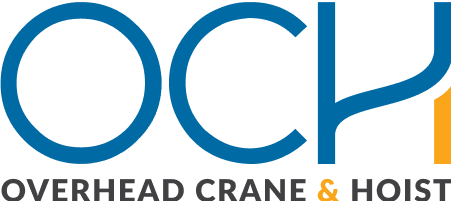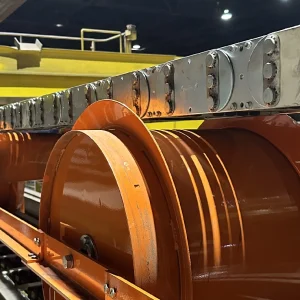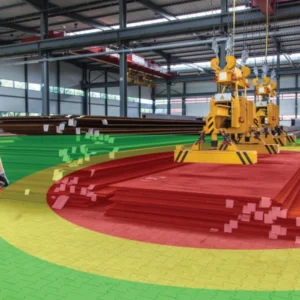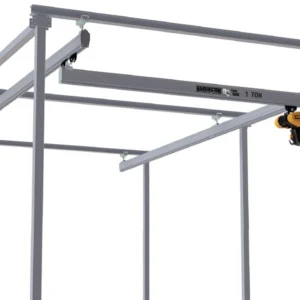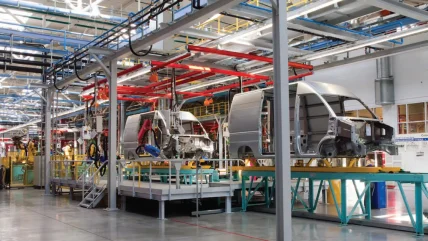
Like most industries, manufacturing has felt the weight of supply chain disruptions and challenges over the past two years. From product delays, like copper and electronics, to labor shortage issues, the industry has been charged with rethinking supply chain processes and how to leverage technology and automation. As a result, industry experts are seeing a partial recovery, meaning that while there are still problems with product orders, the supply chain is experiencing more consistent and reliable lead times for largescale projects.
For those working in manufacturing warehouses and facilities, overhead crane systems fall into that “technology and automation” category, and those who have learned to utilize them effectively have seen a significant impact on operational processes. Specifically, there are three ways overhead cranes can help streamline and strengthen supply chain operations as part of an overarching modernization strategy.
1. Increasing operational efficiency
To successfully boost supply chain processes with overhead crane systems, it is important to prioritize efficiency and throughput. This starts with ensuring your warehouse or facility is a safe working environment. Roughly 300 deaths occurred from 2011-2017 due to crane-related accidents. By upgrading your overhead cranes with modern safety features like collision avoidance systems or automated sensors, you can ensure that your employees are working under safer operating conditions. Moreover, with reduced risks of accidents or injuries comes less downtime and increased efficiency to keep projects moving forward.
Additionally, when considering efficiency, ensuring your equipment is in quality condition is crucial. Similar to safety considerations, when your equipment is run down or experiences high levels of wear and tear, the result can lead to downtime periods. Not only are your operations paused, but you run the risk of increased maintenance repair costs and loss in ROI. Consider implementing a predictive maintenance plan with regularly scheduled checkups to ensure you operate with secure, safe, and regulated technology.
2. Simplifying controls
Another way to optimize your supply chain operation through overhead crane systems is to adopt simplified controls. Depending on your business, this might mean using radio remote control systems instead of pendant pushbuttons or fixed control stations and cabs. Radio remotes allow users to control cranes from anywhere around the load, providing opportunities for more movement and flexibility. You can use these radio controls across your entire overhead crane system or operate with tandem radio controls for larger equipment requiring more than one crane. Safety is another factor where remote users can perform radio control functions from a safe distance rather than standing right next to or directly under a crane when operating.
Because the manufacturing industry has undergone significant labor shortages and employee turnover in recent years – with one report stating a 39% turnover rate in 2022 – it is vital to arm your operators and employees with easy-to-use equipment and controls. Designed with this in mind, radio remotes are more ergonomically sound, lighter weight, and fit comfortably in hand, making it easier for employee usage and enhancing their skills at a fast pace. The more simplified the controls, the more confidence users can gain in their crane operating skills. With simplified controls, you can rest assured that your operators and supply chain operations will continue to move processes forward.
3. Improving communication with full Automation
An extension of improving employee turnover, the third way to optimize your supply chain is prioritizing communication with full automation capabilities. As you think through operator recruitment, consider investing in fully automated technologies that can replace repetitive, mundane tasks typically handled by crane operators. Instead, allow your operators to use their skills in managing complex lifts and higher-volume tasks. With automated technologies, operators and facility managers can gain visibility into which cranes are in motion, when parts are being moved, and what cranes are being operated on at all times. This enhanced visibility paves the way for greater efficiency, safety, and productivity.
Automation is something that’s most effective when built in from the very beginning. When working at greenfield sites and kickstarting a new project, consider investing in automation for your overhead crane systems upfront. Start by gathering as much information on existing processes and technology that is available. Then, you can determine the next steps and implement the best systems that ensure continuous, uninterrupted communication for your equipment.
Moving your supply chain forward
With any technology or equipment investment, you need to be sure of its impact on your business to support the upfront cost. As the manufacturing space navigates an ever-changing supply chain landscaping, some of the most standard pieces of equipment can be your biggest asset if you know how to get the most out of them.
Your overhead crane system can help unlock improved efficiency, productivity, and safety – all of which can help combat labor shortages, manufacturing delays, and reduced throughput. Supply chain optimization can feel like a daunting task, but by approaching your business through a lens of modernization and automation, you can make great strides to keep your business moving forward.
